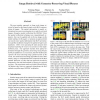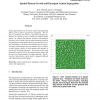ACCV
2010
Springer
13 years 7 months ago
2010
Springer
The ignorance on spatial information and semantics of visual words becomes main obstacles in the bag-of-visual-words (BoW) method for image classification. To address the obstacles...
CVPR
2011
IEEE
13 years 7 months ago
2011
IEEE
The most popular approach to large scale image retrieval is based on the bag-of-visual-word (BoV) representation of images. The spatial information is usually reintroduced as a po...
ICRA
2009
IEEE
13 years 9 months ago
2009
IEEE
We propose a novel method for multi-robot plan adaptation which can be used for adapting existing spatial plans of robotic teams to new environments or imitating collaborative spat...
HCI
2009
13 years 9 months ago
2009
Abstract. The visualization of geographic information requires large displays. Even large screens can be insufficient to visualize e.g. a long route in a scale, such that all decis...
FLAIRS
2009
13 years 9 months ago
2009
Researchers in commonsense, qualitative spatial and temporal reasoning (QSTR) provide flexible and intuitive methods for reasoning about vague and uncertain information including ...
COSIT
2009
Springer
13 years 9 months ago
2009
Springer
People intuitively understand that function and purpose are critical parts of what human-configured entities are about, but these notions have proved difficult to capture formally....
ICANN
2010
Springer
13 years 9 months ago
2010
Springer
The hippocampus is known to be involved in spatial learning in rats. Spatial learning involves the encoding and replay of temporally sequenced spatial information. Temporally seque...
WIAS
2010
13 years 10 months ago
2010
Spatial agent models can be used to explore self-organising effects such as pattern growth and segregation. We employ our predator-prey model to study these emergent behaviours in...
SPATIALCOGNITION
2010
Springer
13 years 10 months ago
2010
Springer
Survey knowledge of spatial environments can be successfully conveyed by visual maps. For visually impaired people, tactile maps have been proposed as a substitute. The latter are ...
PVLDB
2010
13 years 10 months ago
2010
Spatial and temporal data have become ubiquitous in many application domains such as the Geosciences or life sciences. Sophisticated database management systems are employed to ma...







